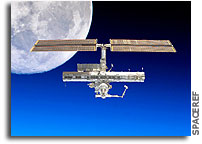NASA Space Station On-Orbit Status 25 May 2003

All ISS systems continue to function nominally, except as noted previously or below.
Second off-duty/rest day for the crew, as Increment 7 moves into its Week 4.
After breakfast (2:40am EDT), the CDR collected the weekly data readings of the Service Module’s (SM) toilet flush and water supply status counters for calldown to MCC-M, then completed the periodic inspection of the Elektron oxygen generator’s VM gas/liquid system for possible obstructing air bubbles.
Later, Yuri conducted his regular care of the on-board pea plants, i.e., the daily monitoring/servicing of the BIO-5 Rasteniya-2 zero-G plant growth experiment in the Lada-2 greenhouse.
On his second day with the Russian Diatomeya program of observing the world’s oceans for bioproductive areas from SM windows 7 and 8, Malenchenko today aimed his Nikon-F5 (80 mm lens) at selected targets in the Atlantic Ocean. [Target zones were the southern boundary of the West Wind Drift NE of the Falklands, the northern boundary of the West Wind Drift near Gough Island, an upwelling zone near the Orange River runoff, color fields in the Bengal bioproductive zone and at the confluence of the Malvinas and Brazil Currents, and the Falkland-Patagonia bioproductive region.]
Later, Yuri completed the daily routine maintenance of SOZh life support systems, which include the ASU toilet facility, food containers (KRP), water containers (EDV) and solid waste containers (KTO), while FE/SO Edward Lu prepared the daily IMS (inventory management system) delta file for automatic export/import to update the database.
Both crewmembers completed their daily 2.5-h program of physical exercise, on TVIS treadmill, RED expander and, for Yuri, on the Russian VELO cycle ergometer with load trainer.
As agreed during yesterday’s weekly planning conference (WPC) of the crew with the ground, tomorrow’s planned MGS/InSPACE and IMS audit activities will be deferred to gain 2h 45min for Malenchenko and Lu to get more preparation time for the EVA/EMU don/doff dry-run on Wednesday.
Remaining open on the Russian task list: the troubleshooting of the Starmail Earth photography experiment. [Some frames taken earlier with the Nikon D1 digital camera showed smudges looking like “soft focus spots”. Yuri and the ground are considering methods for cleaning the camera’s highly sensitive CCD (charged-couple device) matrix.]
At selected times, TsUP today performed more correction tests of the SM’s BINS strap-down navigation/guidance system via S-band comm, using Zvezda’s solar sensor (SD251K) and infrared horizon sensor (IKV256K).
Today’s CEO targets (optional), now no longer restricted by the Lab science window ruled off-limit due to flight attitude, were Wake Island (looking a touch left for detailed views of the fringing coral reefs), Anatahan volcano, Marianas (as Typhoon Chan moves away to the NE, the ash plume of the volcano [plume active 5/23] should have been visible just right of track. The plume is embedded in the typhoon circulation and should have been oriented towards the E or SE), Typhoon Chan, Marianas (low evening lighting on this large storm which was tracking NNE at 7 kts. Maximum sustained winds were estimated at 85 kts, gusting to 105 kts. [Unusual transverse lines of outblow cirrus visible on the satellite image.] Looking right of track), Bombay, India (nadir pass; crew was to try to get the city in one or two views only. Also, smoke was reported over Bombay. Oblique images to document the source of the smoke would be interesting), La Paz, Bolivia (looking a touch right for this city that is located partly on the high desert plateau of the high Andes, and partly in a deep landslide canyon on the eastern edge of the plateau), Tianjin, China (night target; nadir pass over Beijing’s large port city. Looking a touch left for night lights of Beijing), and Berlin, Germany (night target; nadir pass).
CEO images can be viewed at the websites
http://eol.jsc.nasa.gov and
http://earthobservatory.nasa.gov
ISS Orbit (as of this morning, 7:51am EDT [= epoch]):
- Mean altitude — 389.0 km
- Apogee — 393.0 km
- Perigee — 385.1 km
- Period — 92.34 min.
- Inclination (to Equator) — 51.63 deg
- Eccentricity — 0.0005863
- Orbits per 24-hr. day — 15.59
- Mean altitude loss in last 24 hours — 90 m
- Revolutions since FGB/Zarya launch (Nov. ’98) — 25746
- For more on ISS orbit and worldwide naked-eye visibility dates/times, see
- http://www.hq.nasa.gov/osf/station/viewing/issvis.html
Another amazing “Did you know” fact (kindly brought to this report’s attention):
Assembly of the ISS, in volume and wingspan currently equivalent to a B-777 jumbo jet, has to date taken about 650 hours (2 crewmembers doing 50 EVAs @ 6.5 hrs.), with many parts mated in space for the very first time. Compare this to B-777 assembly, which typically takes 432,000 hrs (2000 technicians in three 8-hr. shifts over three month). Wow!








